|
by Craig Hohm - Penn Yan, New York - USA |
I first began to dream of building boats when I was a medical intern; the dream of being undisturbed on the high seas was a very compelling vision in this setting. 5 years later I attended an intro to boat building class in Brooklin, Maine, and while there fell in love with the Catspaw dinghy. This became my first boat, launched in 1989. It is a wonderful little craft, still getting active use sailing and rowing from March to November (and sometimes midwinter.)
 |
P1 - The ribs, keelson and stems were laminated on the lofting floor.
(click images for larger views) |
|
But the desire for a bigger boat ("one with curtains") kept its allure, and in the 1990's I started dreaming in earnest. I wanted something that could handle coastal waters yet was trailerable, practical to maintain yet beautiful, simple but with full capabilities: bunks, engine, toilet, and kitchen. Ultimately I think finding the right boat is like marrying the right woman. If the vision matches reality, you can both grow together with the inevitable limitations that any relationship has. I did not want the showiest or most grand cruiser, but something solid and companionable.
| P2 - The hull was built upside down on molds in the usual way. |

|
|
There were several contenders at first. I would browse the prospects in Woodenboat's catalogs of boat plans. I had a brief fantasy with Alden's Malabar schooner but came to my senses when she threatened my budget and resources. I liked the 18' Williams catboat , Atkins Maid of Endor, and Alden’s 21' double ender (similar overall to the grey seal.) Woodenboat's series of the building of the grey seal clinched it for me. The Wagners made it seem possible and the boat itself was a Nordic beauty; perhaps there was some atavistic response in my Saxon blood.
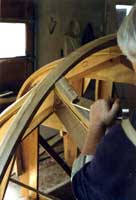 |
P3 - The ribs, keelson and stems were faired on the mold to receive the plank lands |
|
Buying the plans was the official engagement. Now the logistics began. I thought I had all the time in the world; this had been planned as a retirement project sometime in the future. But the sudden death of a younger colleague spurred the start ...in 9/98
I wanted to get as much wood locally as I could and found a stack of 8/4 ash hoarded in a friend's barn. Ash is extremely strong, glues well, and I hoped the mediocre rot resistance would be trumped by epoxy coating (after two years in the water there is no evidence of checking in the exposed ash keel). The planks and bulkheads were marine ply (Bruynzeel;) the hull was built upside down on molds in the usual way: offsets were accurate and the designer (Iain Oughtred) was patient and helpful with my phone calls. The ribs, keelson and stems were laminated on the lofting floor (P1) and faired on the mold to receive the plank lands (p2 or p3). Planks were scarfed on the boat in sections (longest plank was 24'), tied into ribs with screws; Iain felt the screws were unnecessary but I found them reassuring. (p4 hull near completion)
| P4 - The hull near completion. |
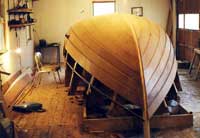
|
|
Two particular tasks occupied significant worry time:
1. Drilling the shaft log. This as a 1 3/8 " hole bored through the solid keel, approx 30" long. The back of the keel fairs to 2" wide and there was not a lot of room for movement in the engine installation. I set up an angled jig behind the boat to control the up- angle and sighted along the floor seams aligned with the keel. The bit was a Forstner set into an old piece of prop shaft (thanks to Dan Sutherland for this). Took about 45minutes and came out within 3/16" of the target. Miller time! (p5)
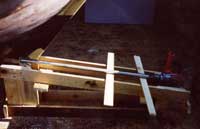 |
P5 - Drilling the shaft log took about 45 minutes and came out within 3/16" of the target. Miller time!
|
|
2. The lead casting is a 1200# complicated piece of hardware with a cb slot. Some how-to articles advocate a plain wooden mold; my first one built following this advice burned to ash (P6). Imagine picking all that lead out of the dirt and starting over. So, I went with the bombproof mold coated with silicate and ceramic cloth. Unfortunately the second try was foiled by a plumbing failure and the lead ran out of the tub before I could get it in the mold. Words cannot convey.... The third try worked. I worked outdoors using a cast iron tub and a wood fire, wearing a 3m respirator. My before and after lead levels were normal. The hull was fit to the keel and the keel to the lead. Then the traditional flipping party (p7); back into the shop upright and onto the interior. It took about two years to this stage.
| P6 - For the lead casting, some how-to articles advocate a plain wooden mold; my first one built following this advice burned to ash. |

|
|
The installation of the engine, waste system, fresh water took another 2 years. There was endless fiddling with the engine, a Volvo diesel, in and out 30+ times trying to get the most efficient use out of a very limited space. The engine weighs 300# and I wore out the welcome with my teenage son on this chore ("please, just one more check?").
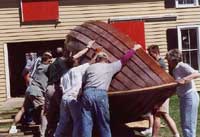 |
P7 - The traditional flipping party; back into the shop upright and onto the interior. It took about two years to this stage.
|
|
Deck beams, decks, cabin trunk and then just a matter of painting and wiring. I remembered to leave off the cabin hatch and the rubrails, avoiding the embarrassment of having to widen the shop doors with a sawzall when we brought it out and lifted it onto the trailer. (P8). The spars were made out of locally cut spruce. Mast and yard are box construction and the boom is solid. Most of the hardware was cordially supplied by Moray McPhail at classicmarine.co.uk. He was endlessly helpful with suggestions about set up and fabricated several custom pieces (rudder hardware and the oval ports). Sails were made by Douglas Fowler of Ithaca, NY who made several site visits to ensure that the unusual high peaked gaff was cut right.
| P8 - I remembered to leave off the cabin hatch and the rubrails, avoiding the embarrassment of having to widen the shop doors with a sawzall when we brought it out and lifted it onto the trailer. |
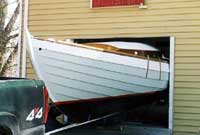
|
|
The goal all along was to trailer to cruising grounds and, the Grey Seal being a 2 tonner, I ordered a custom galvanized trailer from Triad in Connecticut. It is built to the lines of the hull and glides right along behind the pickup. Total gross wt with boat is 6500#.
 |
P9 - The goal all along was to trailer to cruising grounds and, the Grey Seal being a 2 tonner, I ordered a custom galvanized trailer from Triad in Connecticut.
|
|
Altogether the project took 5 1/2 years. As Moray noted, given this time commitment, I missed the TV show "friends" in its entirety.
| P10 - We launched in the spring of 2004... |

|
|
We launched in the spring of 2004 (p9-10) and spent the first year pottering about on Keuka Lake, the home water (p11). The Waterdog (a nickname for the river otter) is not the fastest boat in the fleet but I find I’m heading out when the Catalinas are making for harbor. We have had it out in 25-30 k winds and it charges ahead, dry and steady. First reef goes in about 15, second @ 20, third above 25. I regret that I have no photos of these adventures since my wife, official photographer, will have none of these conditions. I bought her a hand-held Skymaster wind meter and she uses it authoritatively, saying, "Skymaster says it's too windy to be sailing today." at speed the hull generates a tubular vortex off the stern like the old Viking hulls; it is visible for 30 yards aft, 3' under the water, and although of uncertain significance, seems very cool to me.
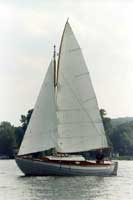 |
P11 - ...and spent the first year pottering about on Keuka Lake, the home water.
|
|
The first actual cruise was Lake Champlain last year: we put in at Essex and spent the night eating restaurant food and setting up the rigging. The next morning we set out for Burlington; two days of restaurant food, book shops and espresso. Met with Nick Patch from the Champlain Maritime Museum about their pilot gig program and had a look at the boats (this museum is highly recommended!). Then north to Valcour Island as hurricane Katrina moved up the coast. We holed up two days there waiting out the squalls (p12). Leaving Valcour we had a 26 mile single-tack reach down to the mouth of otter creek and motored the 8 miles upstream to the town of Vergennes (more restaurant food), then back out in the south end of the lake for a day before going home. Altogether it was a successful test of the boat, equipment and marriage. Driving home she (the wife) agreed to the thousand islands in 2006.
| P12 - We holed up two days there waiting out the squalls |
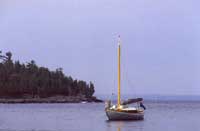
|
|
It’s late February now, most of the off-season chores are done and I’m waiting to get the dog back in the water. The honeymoon is over, and the marriage is doing fine.
|